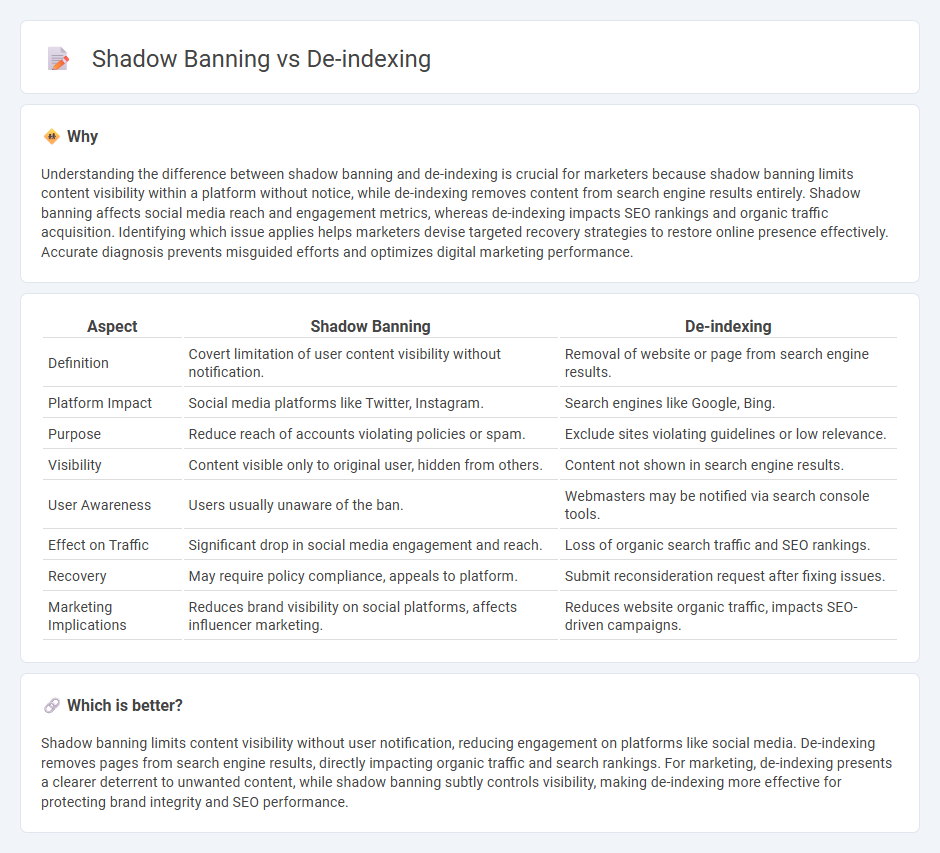
Shadow banning limits the visibility of user content on social media platforms without notifying the user, creating a stealthy form of content suppression. In contrast, de-indexing removes web pages from search engine results, significantly reducing organic traffic by preventing content from appearing in search queries. Explore deeper insights into how these strategies impact digital marketing and online presence.
Why it is important
Understanding the difference between shadow banning and de-indexing is crucial for marketers because shadow banning limits content visibility within a platform without notice, while de-indexing removes content from search engine results entirely. Shadow banning affects social media reach and engagement metrics, whereas de-indexing impacts SEO rankings and organic traffic acquisition. Identifying which issue applies helps marketers devise targeted recovery strategies to restore online presence effectively. Accurate diagnosis prevents misguided efforts and optimizes digital marketing performance.
Comparison Table
| Aspect | Shadow Banning | De-indexing |
|---|---|---|
| Definition | Covert limitation of user content visibility without notification. | Removal of website or page from search engine results. |
| Platform Impact | Social media platforms like Twitter, Instagram. | Search engines like Google, Bing. |
| Purpose | Reduce reach of accounts violating policies or spam. | Exclude sites violating guidelines or low relevance. |
| Visibility | Content visible only to original user, hidden from others. | Content not shown in search engine results. |
| User Awareness | Users usually unaware of the ban. | Webmasters may be notified via search console tools. |
| Effect on Traffic | Significant drop in social media engagement and reach. | Loss of organic search traffic and SEO rankings. |
| Recovery | May require policy compliance, appeals to platform. | Submit reconsideration request after fixing issues. |
| Marketing Implications | Reduces brand visibility on social platforms, affects influencer marketing. | Reduces website organic traffic, impacts SEO-driven campaigns. |
Which is better?
Shadow banning limits content visibility without user notification, reducing engagement on platforms like social media. De-indexing removes pages from search engine results, directly impacting organic traffic and search rankings. For marketing, de-indexing presents a clearer deterrent to unwanted content, while shadow banning subtly controls visibility, making de-indexing more effective for protecting brand integrity and SEO performance.
Connection
Shadow banning and de-indexing both reduce online visibility by limiting content exposure to users, with shadow banning hiding posts within platforms while de-indexing removes them from search engine results. Both practices impact digital marketing strategies by decreasing organic reach and engagement rates, forcing marketers to adapt through diversified channels. Understanding algorithms behind these actions helps brands maintain online presence and manage reputation effectively.
Key Terms
Search Engine Visibility
De-indexing removes a website or specific pages from search engine results, effectively making them invisible to users searching through platforms like Google, which directly impacts organic search traffic and visibility. Shadow banning subtly restricts content reach without user notification, often resulting in reduced engagement or visibility on social media or forums without complete removal from search indexes. Explore further to understand the distinct mechanisms and implications of de-indexing and shadow banning on your digital presence.
Content Moderation
De-indexing removes specific content from search engine results, making it invisible to users but still accessible on the original platform, often used to comply with legal or policy requirements. Shadow banning restricts a user's content visibility without their knowledge, effectively silencing the user by limiting their reach in community forums or social media platforms. Explore deeper insights into content moderation techniques and their impacts on digital visibility and user engagement.
Algorithmic Filtering
De-indexing removes web content from search engine databases, making it invisible to users, while shadow banning restricts visibility on social platforms by hiding posts without user notification. Both methods rely on algorithmic filtering to manage content dissemination based on relevance, compliance, and user behavior patterns. Explore how these techniques impact digital visibility and online presence to strategize more effectively.
Source and External Links
What Is De-indexing - Definition, Examples - Rush Analytics - De-indexing is the removal of a webpage or entire site from a search engine's index, causing it to no longer appear in search results, typically due to guideline violations or technical issues, which severely reduces visibility and traffic.
Removal, De-Indexing, Suppression. What's the Difference? - De-indexing removes content from the search engine's index directly by the search engine itself without deleting the source page, differing from NoIndex which is controlled by the publisher on their site.
How to Get Deindexed in SEO - 7 Methods - SEO Case Study - De-indexing removes a webpage from search results for reasons like guideline violations or duplicate content; it can be done via tools like Google Search Console's URL removal to temporarily or permanently exclude pages.
 dowidth.com
dowidth.com